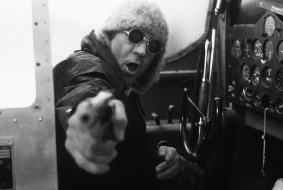Hunter S. Thompson
Hunter S. Thompson, doctor of gonzo journalism, died on February 20th 2005, aged 67

THERE were always way too many guns around at Hunter S. Thompson’s farm in Woody Creek: .44 Magnums, 12-gauge shotguns, black snubnosed Colt Pythons with bevelled cylinders, .22 calibre mounted machineguns. He also kept explosives, to blow the legs off pool tables or to pack in a barrel for target practice. His quiet bourgeois neighbours near Aspen, Colorado, complained that he rocked the foundations of their houses.
Explosions were his speciality. Indeed, writing and shooting were much the same. His very first newspaper story, written when he was ten for a neighbourhood newsletter in Louisville, Kentucky, was headlined “WAR!” (“The Voits declared war on Hunter’s gang on Oct. 1, 1947. At 3.00 Hunter’s gang attacked the Voits”). Later, as a working journalist, he fired off reckless fusillades of words that were meant to shock and entertain and wreak collateral damage.
He had always been a problem, kicked early out of high school (drinking, vandalism) and rapidly out of the air force, but his casual smashing of the rules of American journalism happened more or less by accident. Assigned to cover the Kentucky Derby in 1970, his mind was too blown with drugs, as usual, to write the story. One by one, with his trembling hands, he ripped the pages of whiskey-fuelled ramblings out of his notebook and sent them to the printer. The piece that resulted, “The Kentucky Derby is Decadent and Depraved”, was a runaway success, though he had neither described the race nor mentioned the winner. And he was astonished: it was like “falling down an elevator shaft and landing in a pool of mermaids.”
A friend called his style “totally gonzo”. The name stuck, though, as he confessed, nobody knew what the hell it meant. For the literary, he could explain that it followed William Faulkner’s dictum that “the best fiction is more true than any kind of journalism.” Mr Thompson stalked, rifle in hand, cigarette (in holder) dangling, on the wild borderlands between fact and fiction, leaving readers to decide what was true and what was not.
Editors tried to control him, but failed. Journalistic objectivity was a nonsense to him; he threw it away, and turned his gaze on himself. He and his excursions into depravity became the central and only theme of every story he wrote. Sent to Puerto Rico for the New York Herald Tribune, in 1959, he shot rats at the San Juan city dump until he was arrested. Assigned in 1971 to write a 300-word caption on the Mint 400 motor-cycle race for Sports Illustrated, he wrote the 50,000 words of mayhem that became “Fear and Loathing in Las Vegas”. It began: “We were somewhere around Barstow on the edge of the desert when the drugs began to take hold.” Posted to Zaire in 1974 to cover the fight between George Foreman and Muhammad Ali, he never watched the boxing. Instead he floated naked in the hotel pool, into which he had thrown a pound and a half of marijuana, and let the green slick gather round him.
“Fear and Loathing” made him famous: so famous that the Republicans came courting him, although he was a Democrat. It was not just the guns, but the fact that he wore a twisted sort of patriotism on his sleeve. That journey through the Californian desert to find fame and fortune, stocked up with “two bags of grass, seventy-five pellets of mescaline, five sheets of high-powered blotter acid, a salt shaker half-full of cocaine, and a whole galaxy of multi-coloured uppers”, was also, Mr Thompson claimed, “a classic confirmation of everything right and true and decent in the national character.” (“Jesus! Did I say that?”)
Nixon’s men wondered if this madman could be their bridge to the alienated,war-hating young. But they were playing with fire. Mr Thompson thought Nixon a liar and a bastard. He covered the 1972 election in typically take-no-prisoners style, producing what one campaign aide called “the least accurate and most factual” book about it; and when he toyed with politics it was on the Freak Power ticket, running for sheriff of Pitkin County, Colorado, where he could blow things away in the woods.
He did not give “a flying fuck” what he smoked, or ingested, or did, but there was a thoughtful side. Early in his career, in an obituary of a friend, he wrote of “the dead-end loneliness of a man who makes his own rules.” He was often melancholy, and wild conviviality and celebrity made no difference to that. The epigram to “Fear and Loathing” quoted Dr Johnson: “He who makes a beast of himself gets rid of the pain of being a man.” It was not thought surprising that his death was a suicide.
In 1964 he had made a long journey to Ketchum, Idaho, to the grave of Ernest Hemingway, one of his models and heroes. He wanted to understand why Hemingway had killed himself in his cabin in the woods, and concluded that he had lost his sense of control in a changing world:
It is not just a writer’s crisis, but they are the most obvious victims because the function of art is supposedly to bring order out of chaos, a tall order even when the chaos is static, and a superhuman task when chaos is multiplying ... So finally, and for what he must have thought the best of reasons, he ended it with a shotgun.